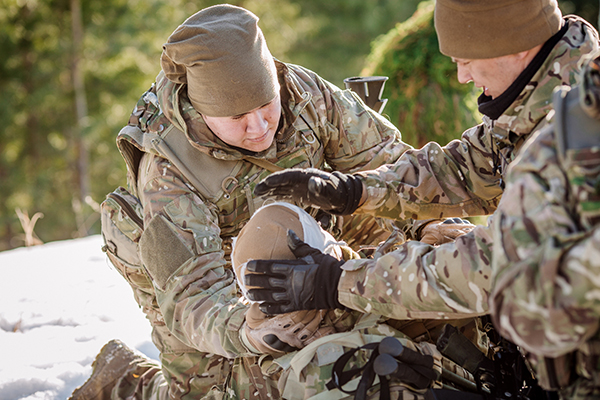
In many common emergencies or accidents, it's important to address injuries as soon as possible with first aid or CPR while waiting for -- or trying to reach -- professional medical help. This gives the victim a fighting chance at surviving the ordeal. In the case of people whose jobs put them right in the middle of life-threatening situations, such as soldiers and cops, they have what is called the TCCC. (h/t to DoomAndBloom.net)
Tactical Combat Casualty Care (TCCC) is a set of guidelines and recommendations regarding pre-hospital care for wounded soldiers on the battlefield. These guidelines help save the lives of not just military and law enforcement officers, but also civilians, who would otherwise die during or in the aftermath of a disaster.
Care under fire, ALS, TACEVAC
Once a soldier is down (injured, but not dead) in the middle of a firefight, the medic must first get the victim out of the line of fire, or out of a burning vehicle, all while making sure not to get wounded or killed himself. The medic and the victim himself, if possible, must stay mentally alert and still actively engage the enemy while trying to move away to a more secure position for emergency care.
While under fire, the medic won't have time to examine the victim's body thoroughly for specific injuries, so it's recommended to use tourniquets where possible, such as on the extremities. Place the tourniquet high and tight on the injured arm or leg.
Other interventions should be delayed until the immediate threat to both medic and victim is neutralized and they have moved to a safer area. Once those have been accomplished, the medic can now perform tactical field care, often referred to as advanced life support (ALS).
Once the medic and the patient have moved to an area with a secure perimeter, the medic can then perform ALS. Depending on the location and severity of the injury, ALS may involve placing an IV line or performing surgery. ALS includes sealing sucking chest trauma, treating a tension pneumothorax (collapsed lung), bandaging wounds, splinting fractures, preventing hypothermia, and addressing shock.
After the medic has performed the required ALS, he can then request for a tactical evacuation (TACEVAC) or transporting the victim to higher medical resources for definitive care. (Related: Emergency preparedness: What you need to know about crush injuries.)
MARCH/PAWS
Once the victim has been transported away from the battlefield, the medic can now make a thorough evaluation of the extent and severity of the victim's injuries. In this examination, the medic must address MARCH:
- Massive hemorrhage – The medic establishes, continues, or improves the control and prevention of life-threatening bleeding using tourniquets, hemostatic agents, pressure dressings, pelvic binders, and other means necessary.
- Airway – The medic establishes and maintains a reliable airway using devices or procedures, such as chin lift, jaw thrust, recovery position, nasal airways, and others.
- Respiration – The medic seals open chest wounds, decompresses collapsed lungs and ventilates to ensure the flow of oxygen in the victim's lungs. He may use a bag-valve-mask and oxygen tank if available, or insert a tube into the victim to serve as a passageway for oxygen (intubation).
- Circulation – The medic administers IV fluids if the victim is in shock. This may involve giving blood or other related products.
- Hypothermia – The medic must prevent hypothermia by removing wet clothing, covering the victim with dry blankets, and establishing a barrier between the cold ground and the victim. Some also use "H" for "head" as in treating traumatic head injuries.
Once the medic has addressed MARCH, he may perform an additional survey of the patient's medical needs, called PAWS:
- Pain management.
- Antibiotics to prevent infections.
- Wound reassessment and care.
- Splinting fractures and stabilizing limb dressings.
To get a better idea of how to perform TCCC, the following video from Brighteon.com details its different phases and the steps and skills that you need to know.
In survival situations, you may not be able to duplicate professional medical care from a hospital or trauma center, but learning to perform TCCC can help increase a person's chances of survival.
However, keep in mind that even after learning TCCC, you will not always have positive outcomes. Still, do everything you can to help another, especially in these troubled times.
Sources include:
Please contact us for more information.














